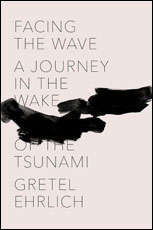— Samuel Beckett
"As if not beautiful enough, the wrinkled ocean smooths its own skin. Wave follows wave. It's been six months since the earthquake, tsunami, and nuclear meltdown, and everywhere in Japan there are ceremonies commemorating the dead.
"At 2:46 p.m. a moment of silence is observed. Buddhist monks chant the Heart Sutra and the parents of dead children fly paper cranes. In the town of Higashi-Matsushima thousands of candles are lit. In Ishinomaki and Otsuchi white paper lanterns with flickering candles are sent afloat on rivers. In what was Rikuzentakata, a town that vanished in twelve minutes, a memorial service for the city's dead is held in its one remaining hillside temple. After, a bonfire is lit. The blaze is encircled by cut cedar boughs and bamboo poles hung with gohei — sacred white papers cut in zigzag shapes (not unlike images of lightning) that represent the presence of the kamisama. Divinity resides everywhere.
"The euphoria of survival evident in June is now tinged with despair. A futureless future looms. The exact way to live with grief and resurrect one's life and livelihood is in no way clear. No one who lost a house is being allowed to rebuild in the tsunami zone. Instead, they live in temporary housing and plant winter vegetable crops; a few try to remake their homes out of rubble. The ruined coast spins out black haze. Crematoriums have been rebuilt and the dead are sent to the fires, their ashes set under polished granite gravestones, as if something of them might stay.
"Sputtering rain and shuushi — a word whose two characters represent 'fall' and 'thought,' meaning the lonely feeling of autumn — that's what it's like today. My September Hana Fuda card features kiku — chrysanthemum — a flower used for funerals. Outside the Sendai grocery store where we stop to buy peanuts and beer, a pony stands in a small enclosure munching hay. A lone child steps forward, extends his hand toward the soft muzzle. To touch the living; to ingest the smell of horse and hay.
"Oceans are depicted in ancient paintings in mesmerizing continuums of moving water, and it's no wonder why. Major earthquakes and tsunamis have occurred in Tohoku for so long, its ground-shakes and waves are a kind of geo-religious ritual. There was the huge tsunami of 1869, one in 1933 that destroyed Kamaishi Bay, and quakes in 1968, 1978, 2005, and 2008. I'm trying to see the lonely beauty in this wreckage, the frozen moment of its undulating rubble, itself a kind of wave.
"The unshackled, the undecorated, the rusting, the collapsed, the disentangled, and the bent — it's all here — an alphabet to make a double soup: one, a dark broth of the dead, and the other, swirled on top, a foamy stream of space and beauty."
